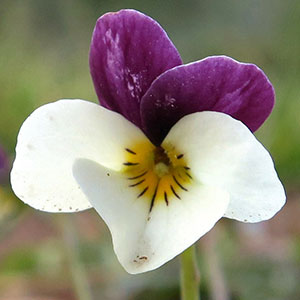Viola hallii
Viola tripartita
Hall's violet, Oregon violet, wild pansy
three-part or Piedmont or threepart violet, threepart violet
1–3, decumbent or ascending to erect, ca. 1/2 subterranean, glabrous, clustered on single, short, vertical, deep-seated caudex.
1(2), erect, leafless proximally, leafy distally, glabrous or puberulent, from subligneous rhizome.
basal and cauline;
basal: 1–4, palmately compound, ± 2-ternate or 3-ternate, leaflets 3;
stipules adnate to petiole, forming 2 linear-lanceolate wings, unlobed, margins entire, apex of each wing free, acute;
petiole 5–8 cm, glabrous;
blade ovate to deltate, 2.8–6 × 2.6–6.5 cm, ± coriaceous, base tapered, ultimate lobes narrowly elliptic, lanceolate, or oblanceolate, 1–7 mm wide, margins entire, ciliate or eciliate, apex acute, mucronulate, surfaces glabrous;
cauline similar to basal except: stipules usually lanceolate, sometimes broadly ovate, ± leaflike, margins toothed;
petiole 1.3–6 cm;
blade 2–4.8 × 1.2–5.5 cm.
basal and cauline;
basal: 0(–2);
stipules ovate, not leaflike, margins entire, apex acute to acuminate, surfaces glabrous or puberulent;
petiole 9–11.5 cm, glabrous or puberulent;
blade unlobed, ovate, or 3–5-lobed, 4–5 × 1–5 cm, base cordate, margins entire or crenate-serrate, ciliate or eciliate, apex acute, surfaces glabrous or ± puberulent;
cauline similar to basal except: restricted to distal ends of stems;
stipules ovate to oblong;
petiole 0.7–7.2 cm, glabrous or puberulent;
blade unlobed, ovate or deltate, or 3-lobed (if 3-lobed, lateral lobes falcate, middle rhombic, longer than others, lobes may appear petiolate; unlobed and 3-lobed leaves can occur on same plant), 1–6 × 0.5–5.5 cm, base truncate to cuneate, margins serrate, ciliate or eciliate, surfaces glabrous or pubescent.
2.5–11 cm, glabrous.
1.5–4 cm, glabrous or pubescent.
sepals lanceolate to ovate, margins ciliate, auricles 0.5–1 mm;
petals: upper 2 almost black abaxially, dark reddish violet adaxially, lower 3 pale yellow, cream, or ± white, lateral 2 bearded, with deep yellow to orange patch basally, dark reddish violet-veined, lowest with deep yellow to orange patch basally, dark reddish violet-veined, 5–18 mm, spur yellow, gibbous, 0.5–2 mm;
style head bearded; cleistogamous flowers absent.
sepals lanceolate to ovate, margins ciliate or eciliate, auricles 0.1–0.5 mm;
petals lemon-yellow adaxially, upper 2, rarely others, brownish purple abaxially, lowest and usually lateral 2 brownish purple-veined, lateral 2 and sometimes lowest bearded, lowest 10–18 mm, spur yellow, gibbous, 0.5–2 mm;
style head bearded; cleistogamous flowers axillary.
ellipsoid, 4–12 mm, glabrous.
ovoid to ellipsoid, 9–12 mm, glabrous.
light brown, shiny, 3.2–3.5 mm.
beige, bronze, or brown, 2.4–3 mm.
= 60, 72.
= 12.
Viola hallii
Viola tripartita
Viola hallii was discovered on the grounds of Willamette University in Salem, Oregon, by Elihu Hall, a professor at that institution (V. B. Baird 1942). Leaves of V. hallii are similar to V. beckwithii.
(Discussion copyrighted by Flora of North America; reprinted with permission.)
Some authors recognize two varieties of Viola tripartita based on lobed versus unlobed leaves. F. L. Lévesque and P. M. Dansereau (1966) suggested that leaf variation is the only character difference between vars. tripartita and glaberrima. N. H. Russell (1965) stated that V. tripartita plants with lobed and unlobed leaves are sympatric and frequently intergrade and did not recognize them as distinct. The situation with two leaf forms in V. tripartita is similar to V. lobata, which also has two leaf forms.
(Discussion copyrighted by Flora of North America; reprinted with permission.)


